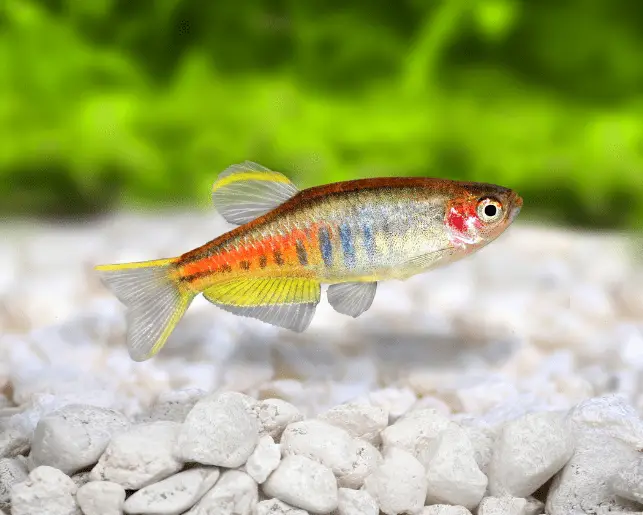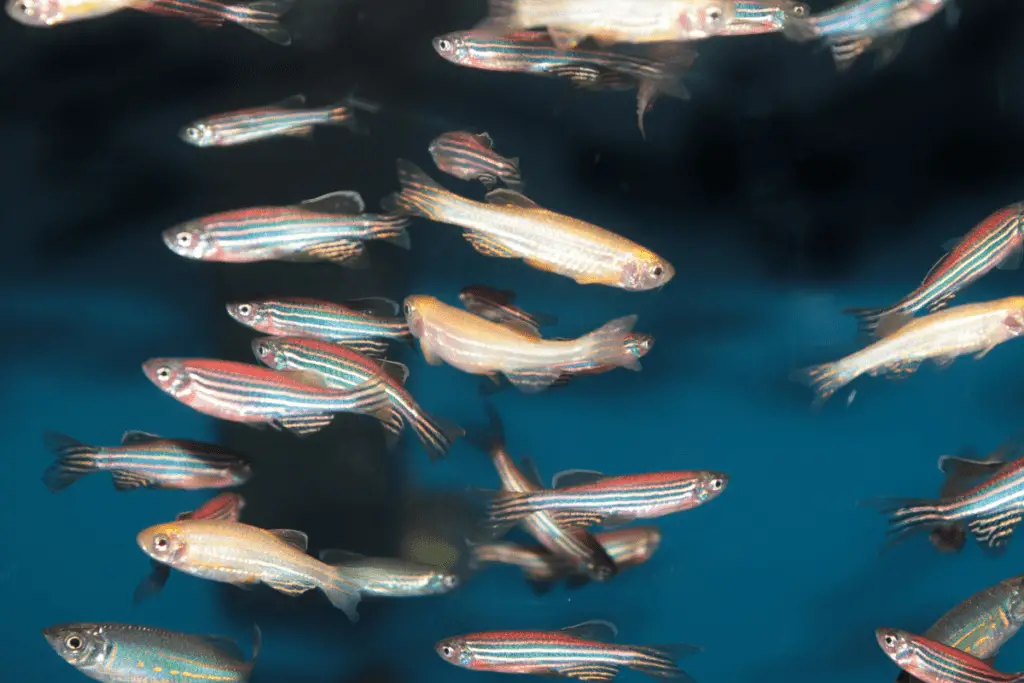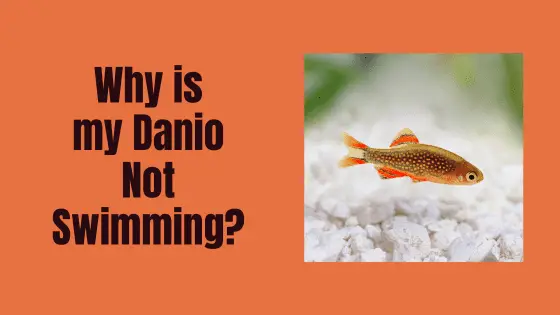Danios are probably the liveliest fish you can have in a tank. so, noticing that one of your danios isn’t swimming will be fairly easy to spot, but can also be concerning. Your danio might stay in the bottom of the tank or hide away in a corner, but it doesn’t swim. If you’ve never encountered this before, you might be wondering what is going on.
If your danio is not swimming, it could be down to poor water quality, illness, overcrowding or stress. Your danio could also be ready to lay eggs.
As you can see, there are a number of reasons why your danio has stopped swimming. However, most of these causes can easily be fixed if you are alert and treat them early.

Why Has My Danio Stopped Swimming?
Usually, fish that aren’t swimming is a warning sign, and you will have to act fast. While some causes of a danio not swimming can be cured, others are temporary and nothing to worry about.
However, knowing what to watch for when your danios aren’t swimming is essential for you to treat them right.
Here are some causes for danios not swimming and how to rectify any problem.
1. Your Danio Is Preparing to Lay Eggs.
If you notice your female danio is staying in one corner of the tank and not swimming around, it can signify that she is about to lay eggs. This process is known as nesting.
If you aren’t sure if your danio is carrying eggs, there are a few physical and behavioural signs you can look out for.
Female danios tend to be a bit plump anyway (sorry girls!), but you may notice she is looking more rotund than usual. You may also notice a dark, triangular patch near the base of the fin. This is known as the gravid spot.
Behaviour wise, you may notice your danio hovering near the bottom of the tank, near to plants and ornaments. This is because danios typically lay their eggs on these surfaces, and the female may be looking for a suitable spot to deposit their eggs.
2. Swim Bladder Disease
Swim bladder disease, also known as swim bladder disorder, is a common health issue that affects fish, including danios. The swim bladder is an internal organ that helps fish control their buoyancy and stay at the desired depth in the water. When the swim bladder is not functioning properly, the fish may experience difficulty swimming and may display other symptoms of swim bladder disease.
Symptoms of Swim Bladder Disease
The symptoms of swim bladder disease can vary depending on the severity of the condition, but some common signs to look out for include:
- Difficulty swimming: Fish with swim bladder disease may struggle to swim or float properly. They may float to the surface, sink to the bottom of the tank, or swim in an irregular, uncoordinated manner.
- Loss of balance: Fish with swim bladder disease may appear unbalanced or tilt to one side. They may have difficulty maintaining their equilibrium and may struggle to stay upright.
- Loss of appetite: Fish with swim bladder disease may lose interest in food and may become lethargic or inactive.
- Bloating: Fish with swim bladder disease may appear bloated or swollen in the abdominal area. This is due to the accumulation of gas or fluid in the swim bladder or other internal organs.
- Inactivity: Fish with swim bladder disease may become less active and may spend more time resting or floating near the surface of the water.
Causes of Swim Bladder Disease
Swim bladder disease can be caused by a variety of factors, including:
- Overfeeding: Feeding fish too much or giving them food that is difficult to digest can cause swim bladder disease.
- Constipation: Fish that are constipated or have impacted bowels may develop swim bladder disease.
- Infection: Bacterial or viral infections can affect the swim bladder and lead to swim bladder disease.
- Genetics: Some fish may be more prone to swim bladder disease due to genetic factors.
Treatment for Swim Bladder Disease
Treatment for swim bladder disease will depend on the underlying cause of the condition. Some things you can do to help your fish recover from swim bladder disease include:
- Reduce feeding: Feeding your fish less or switching to a lighter, more easily digestible food can help reduce the symptoms of swim bladder disease.
- Adjust water parameters: Maintaining good water quality and adjusting the temperature and pH of the water can help promote healing and reduce stress on the fish.
- Add aquarium salt: Adding aquarium salt can help reduce inflammation and promote healing.
- Medication: In some cases, medication may be necessary to treat bacterial or viral infections that are causing swim bladder disease.
If you suspect that your danio or other fish is suffering from swim bladder disease, it’s important to take action quickly to help them recover. With proper care and attention, many fish with swim bladder disease can make a full recovery and return to their normal, active selves.
3. Fin Rot
Fin rot, also known as tail rot or fin decay, is a bacterial infection that affects the fins and tails of fish, including danios. The condition is caused by the bacteria Pseudomonas fluorescens and can quickly spread throughout the aquarium if left untreated. It is important to recognize the signs of fin rot early and take action to prevent the spread of infection.
Symptoms of Fin Rot
The symptoms of fin rot can vary depending on the severity of the infection, but some common signs to look out for include:
- Frayed or ragged fins: The edges of the fins may appear frayed or ragged, and the fins themselves may begin to deteriorate.
- Discoloration: The fins may become discolored or may develop white or gray patches. The affected areas may also appear fuzzy or fuzzy-looking.
- Redness: The affected area may appear red or inflamed.
- Loss of fin tissue: In severe cases, the fin tissue may be completely destroyed, leaving only the fin rays behind.
- Behavioral changes: Fish with fin rot may become more lethargic, may lose their appetite, or may hide in the aquarium.
Causes of Fin Rot
Fin rot is usually caused by poor water quality or other stress factors in the aquarium. Some common causes include:
- Poor water quality: High levels of ammonia or nitrite in the water can weaken a fish’s immune system and make them more susceptible to infection.
- Overcrowding: Overcrowding can create a stressful environment for fish and increase the likelihood of disease transmission.
- Injury: Fins that are torn or damaged are more susceptible to infection.
- Poor diet: Fish that are not getting the proper nutrition they need are more susceptible to disease.
Treatment for Fin Rot
Treatment for fin rot will depend on the severity of the infection. Some things you can do to help your fish recover from fin rot include:
- Improve water quality: Regular water changes and maintaining good water quality are essential for preventing and treating fin rot.
- Remove infected tissue: In severe cases, the affected tissue may need to be trimmed or removed to prevent the infection from spreading.
- Medication: Antibiotics can be used to treat bacterial infections like fin rot. It is important to follow the dosage and duration of the medication as directed.
- Quarantine: Infected fish should be removed from the main aquarium and placed in a quarantine tank to prevent the spread of infection.
Preventing Fin Rot
The best way to prevent fin rot is to maintain good water quality and provide a stress-free environment for your fish. This includes:
- Regular water changes: Regular water changes can help maintain good water quality and reduce the risk of infection.
- Proper diet: Feeding your fish a balanced and nutritious diet can help keep their immune systems strong.
- Avoid overcrowding: Ensure that your aquarium is not overcrowded and that there is plenty of space for your fish to swim.
- Minimize stress: Minimize stress on your fish by providing them with adequate hiding places and by avoiding sudden changes in water temperature or other conditions.
By recognizing the signs of fin rot early and taking steps to prevent and treat the infection, you can help keep your danios and other fish healthy and thriving.
4. Ich
Ich, also known as white spot disease, is a common parasitic infection that affects many species of freshwater and saltwater fish, including danios. It is caused by the parasite Ichthyophthirius multifiliis, which attaches itself to the skin and fins of the fish, causing small white spots to appear.
Symptoms of Ich
The symptoms of ich can vary depending on the severity of the infection, but some common signs to look out for include:
- White spots: The most common sign of ich is the appearance of small, white spots on the skin and fins of the fish. These spots are usually 1-2mm in diameter and may appear raised or fuzzy.
- Lethargy: Fish with ich may become more lethargic or lose their appetite.
- Rapid breathing: Fish with ich may breathe more rapidly than normal, and may appear to be gasping for air.
- Flashing: Fish may also exhibit flashing behavior, which involves rubbing against objects in the aquarium in an attempt to scratch or remove the parasites.
- Fins clamped: The fins of the fish may appear clamped or held close to the body.
Causes of Ich
Ich is caused by the parasite Ichthyophthirius multifiliis, which can be introduced into an aquarium through infected fish, plants, or equipment. The parasite is also more likely to infect fish that are stressed or have weakened immune systems due to poor water quality, overcrowding, or other factors.
Treatment for Ich
Treatment for ich usually involves a combination of medication and environmental changes to eliminate the parasite and prevent its spread. Some things you can do to help your fish recover from ich include:
- Increase water temperature: Raising the temperature of the aquarium to between 80-85°F can help speed up the life cycle of the parasite and make it more vulnerable to treatment.
- Medication: There are several over-the-counter medications available that can be used to treat ich. These medications can be added directly to the aquarium water, and it is important to follow the dosage and duration of the medication as directed.
- Salt baths: Salt baths can be used to help reduce the number of parasites on the fish. To do this, the fish are placed in a separate container with a salt solution for a few minutes, and then returned to the aquarium.
- Quarantine: Infected fish should be removed from the main aquarium and placed in a quarantine tank to prevent the spread of infection.
Preventing Ich
The best way to prevent ich is to maintain good water quality and provide a stress-free environment for your fish. This includes:
- Regular water changes: Regular water changes can help maintain good water quality and reduce the risk of infection.
- Proper diet: Feeding your fish a balanced and nutritious diet can help keep their immune systems strong.
- Avoid overcrowding: Ensure that your aquarium is not overcrowded and that there is plenty of space for your fish to swim.
- Quarantine new fish: New fish should be quarantined for several weeks before being added to the main aquarium to ensure that they are not carrying any parasites or diseases.
By recognizing the signs of ich early and taking steps to prevent and treat the infection, you can help keep your danios and other fish healthy and thriving.
5. Improper Tank Conditions
As you may have noticed, danios can become sick due to improper tank conditions. Your danio may also stop swimming around or hide away in the tank’s corners if the tank is dirty. In addition, they may stop eating and exhibit strange behavior, such as fighting.
To prevent your danios from getting sick, you must ensure their tank is clean and constantly oxygenated. Don’t overfeed your them as this can cause the water to become toxic and dirty the tank. Keep the tank’s temperature optimal for danios, and carefully monitor them to determine if there is anything wrong with the tank.
6. Stress
If you notice your danios aren’t swimming around the tank as much, it’s possibly because they are stressed. If there is a bigger fish in the tank that threatens them, or if they aren’t fed the proper nutrients, they won’t feel comfortable and may react by stopping to swim or roam around the tank.
To prevent this from happening, don’t put aggressive fish in the same tank as danios. Also, don’t put too many in one tank. Finally, ensure you feed your fish a diet high in nutrients so they have everything they need to be healthy.
7. New Danios
If you add a new danio to the tank, it will likely stay close to the bottom or in one corner of the thank first. Once it has adjusted to the new tank and feels that there aren’t any predators or danger in the water, they will slowly start exploring its tank and then swim around.
In this case, you don’t have to worry if your new danio isn’t swimming much. It will slowly adjust and then swim around with the other danios. Don’t place a new danio in a tank with aggressive fish. Ensure the tank is clean, when adding any new fish, so it doesn’t get sick.

8. Injury
An injured fish won’t swim around the tank. Your danio’s fins or body may have been injured by another fish attacking it. In that case, the danio will likely stay close to the bottom of the tank or hide away in the tank’s corners.
To prevent your danios from getting injured, we recommend keeping them in a tank with fish that aren’t aggressive towards them. Danios are known as dither fish for good reason, so it is best not to have them in the same tank as fish that get easily wound up.
9. Your Danio has gone to Danio Heaven.
I have put this last, but really, it should be the first thing you should be working out if your danio isn’t swimming.
Not all dead fish sink to the bottom of the tank, or float to the top.
If your danio has lost its color, has glazed over eyes, and is looking a bit rigid, then it has more than likely passed away. This article I have written will help you with what to do if one of your fish dies.
Conclusion
It’s important to identify the underlying cause of your danio’s behavior so that you can take appropriate steps to address the issue. If you’re unsure what’s causing the problem, it’s always best to consult with an experienced aquarium hobbyist or a veterinarian who specializes in aquatic animals.
Overall, keeping their tank clean and in optimal condition is the key to ensuring your guppies are healthy and able to swim around. Feed them a diet high in nutrients and quarantine any sick danios to prevent the illness from spreading.
More Danio Related Articles:
Will different types of danios school together?


